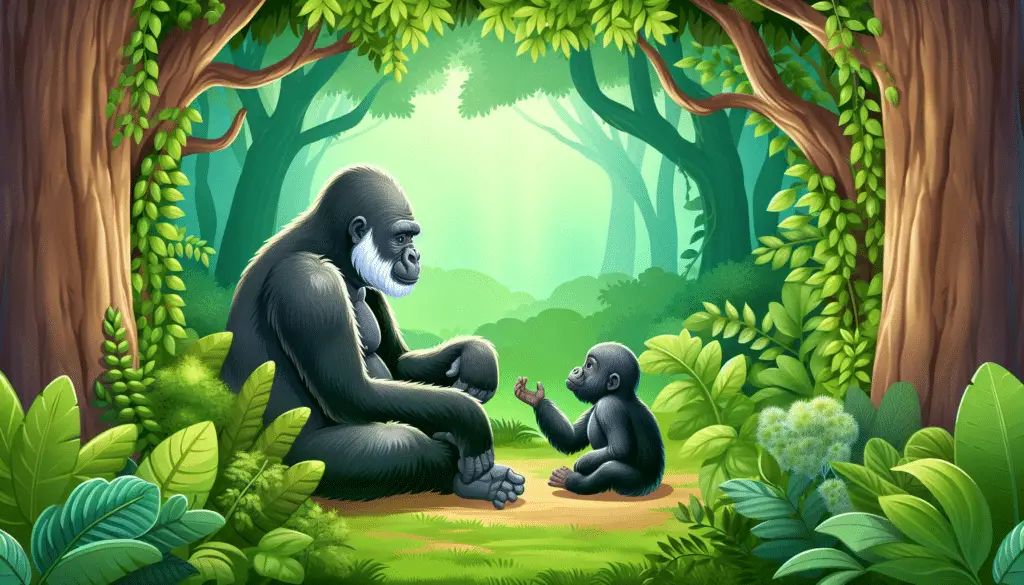How Long Do Gorillas Live in the Wild?
Table of Contents
ToggleIn their natural habitat, **gorillas live on average for about 35 years**.
However, this lifespan can vary based on several factors, including their species, environment, and threats they face.
For instance, western lowland gorillas tend to live slightly shorter lives due to higher human activity in their habitat compared to mountain gorillas.
Let’s dive into some specifics.
Life Expectancy of Different Gorilla Species
As we mentioned earlier, there are two main species and several subspecies of gorillas.
Each has its own average lifespan.
Western Lowland Gorillas
Western lowland gorillas typically live up to 35 years in the wild.
They can live up to 50 years under optimal conditions in captivity.
This increased lifespan in captivity is largely due to better medical care and absence of predators.
Cross River Gorillas
Cross River gorillas have a slightly lower lifespan of around 30 years in the wild.
Due to hunting and habitat loss, they face more threats that can reduce their average age.
These unique gorillas are critically endangered, with fewer than 300 individuals left.
Mountain Gorillas
Mountain gorillas often live up to 40 years in the wild if not affected by human activities or diseases.
These gorillas benefit from living in protected national parks, but they still face risks from poaching and disease.
In captivity, their life expectancy can extend to around 50 years.
Eastern Lowland Gorillas
Eastern lowland gorillas also have a life expectancy of 35-40 years in the wild.
Similar to other subspecies, they can live longer in captivity, often reaching up to 50 years.
However, they remain critically endangered due to habitat destruction and poaching.
Factors Affecting Gorilla Lifespan
Several factors contribute to the varying lifespans of gorillas across different habitats and conditions.
Let’s explore some of the key elements.
Habitat and Environment
The quality of the habitat plays a significant role in the life expectancy of gorillas.
Gorillas living in protected areas with abundant food sources and minimal human interference tend to live longer lives.
Conversely, those in regions with high levels of poaching, habitat destruction, and disease have shorter lifespans.
Diet and Nutritional Availability
A gorilla’s diet greatly impacts its overall health and longevity.
Gorillas in the wild have access to a variety of vegetation and occasional insects, providing a balanced diet.
In captivity, their diet is carefully managed to ensure they receive all necessary nutrients, often leading to longer lifespans.
To learn more about how a gorilla’s diet compares to other herbivores like deer, you can click here.
Predators and Human Interaction
While adult gorillas have few natural predators, human activities pose the greatest threat to their survival.
Habitat loss, poaching, and disease transmission from humans can significantly reduce their lifespan.
Efforts in conservation and law enforcement are crucial in protecting gorillas and extending their lives.
Health and Disease
Like humans, gorillas are susceptible to various diseases that can impact their lifespan.
Common illnesses include respiratory infections, heart disease, and diseases transmitted from humans such as Ebola and, more recently, coronaviruses.
Proper health monitoring and medical care in captivity can mitigate these risks and enhance their lifespan.
Impact of Parasitic Infections
Parasitic infections are another common cause of mortality among gorillas.
Intestinal parasites can lead to severe malnutrition and reduce overall health.
In both wild and captive populations, regular health checks and treatments are necessary to manage these infections.
To see how other species deal with parasitic issues, you can click here.
Lifespan Comparison with Other Primates
When compared to other primates, gorillas have lifespans that align closely with those of chimpanzees and some large monkey species.
Chimpanzees, for example, live an average of 33 years in the wild, similar to gorillas.
Both species face similar threats from habitat loss and human activities.
By comparison, smaller primates generally have shorter lifespans due to higher predation rates and different ecological pressures.
How Gorillas Compare to Other Animals
Gorillas have lifespan ranges similar to mid-sized mammals like deer and elk.
For example, whitetail deer typically live up to 7-10 years in the wild, but can extend up to 20 years in captivity.
Moose have lifespans ranging up to 15-20 years.
To explore more on deer, check out this detailed resource.
Conservation Efforts to Extend Gorilla Lifespan
Conservation plays a critical role in extending the lifespan of endangered gorillas.
Protected national parks and wildlife reserves are essential in providing safe habitats.
Anti-poaching laws and efforts are also vital to their survival.
Research and Monitoring
Ongoing research and monitoring of gorilla populations contribute to better understanding and protection strategies.
Organizations like the Dian Fossey Gorilla Fund and the World Wildlife Fund are at the forefront of these efforts.
They study gorillas’ behavior, health, and social structures to implement effective conservation plans.
Studying such efforts helps us draw comparisons with other species like the deer group.
Community Involvement
Involving local communities in conservation efforts is also critical.
Educating and providing alternative livelihoods to people living near gorilla habitats can reduce hunting and habitat destruction.
Engaging local communities fosters a sense of ownership and responsibility towards conservation.
Technological Advances
Technological advances play an increasing role in gorilla conservation.
Remote sensing, camera traps, and genetic tools help track and monitor gorilla populations effectively.
These technologies enable better management and protection of gorilla habitats.
Gorillas in Captivity: Extending Lifespan through Care
Gorillas in captivity benefit from regular health check-ups and veterinary care.
This attention significantly extends their lifespan compared to their wild counterparts.
Zoos and sanctuaries provide controlled environments with balanced diets and enrichment activities.
Well-managed facilities play a vital role in the conservation and education about gorillas.
Pros and Cons of Gorillas in Captivity
Advantages
- Enhanced medical care and regular health monitoring.
- Absence of predators and fewer threats from poaching.
- Stable and balanced diet ensuring proper nutrition.
- Conservation and educational opportunities for the public.
Disadvantages
- Smaller, confined spaces compared to their natural habitats.
- Potential stress from human interaction and enclosure limits.
- Limited social structures compared to wild troops.
Interesting Gorilla Facts
Gorillas have a unique set of traits and behaviors that are fascinating to learn about.
They share 98% of their DNA with humans.
A fully grown silverback is stronger than 20 adult humans combined.
Gorillas exhibit distinct nose prints, much like human fingerprints.
Understanding these unique traits helps in formulating better conservation strategies.
Conclusion and Content Area 2 of 2<|vq_5025|>
How to Help Gorilla Conservation Efforts
If you are passionate about gorillas and want to contribute to their conservation, there are many ways to help.
Supporting organizations dedicated to gorilla preservation is a great place to start.
The Dian Fossey Gorilla Fund and the World Wildlife Fund are two such organizations doing impactful work.
You can also get involved by adopting a gorilla or funding research projects.
Engaging in eco-tourism responsibly by visiting national parks and wildlife reserves can also contribute to conservation efforts.
Educating others about the importance of gorilla conservation can create a network of aware and active supporters.
The more people understand the threats gorillas face, the better equipped we are to make a difference.
Frequently Asked Questions Related to Gorilla Lifespan
How long do gorillas live in captivity?
In captivity, gorillas can live up to 50 years due to better medical care and nutrition.
Do gorillas live longer in the wild or captivity?
Gorillas generally live longer in captivity due to the absence of natural predators and enhanced medical care.
What is the lifespan of a mountain gorilla?
Mountain gorillas can live up to 40 years in the wild and around 50 years in captivity.
What factors contribute to a gorilla’s longevity?
Factors include habitat quality, diet, medical care, and the presence of threats like poaching and diseases.
Can gorillas live up to 60 years?
While rare, some gorillas in captivity, like Fatou, have lived into their 60s.
How does a gorilla’s diet affect its lifespan?
A balanced diet rich in vegetation and occasional insects can significantly improve a gorilla’s health and longevity.
Do all gorilla species have the same lifespan?
No, different species have varying lifespans. For example, Cross River gorillas have a shorter average lifespan compared to mountain gorillas.
Are human activities the biggest threat to gorillas?
Yes, human activities like poaching, habitat destruction, and disease transmission are significant threats to gorilla populations.
Is there a difference in lifespan between male and female gorillas?
There is no significant difference in lifespan between male and female gorillas.
How do conservation efforts impact gorilla lifespans?
Conservation efforts, including protected habitats and anti-poaching laws, play a crucial role in extending the lifespan of endangered gorillas.
Understanding the Social Structure of Gorillas
The social structure of gorilla troops is fascinating and complex.
Typically, a troop consists of a dominant silverback, several females, and their offspring.
The silverback is responsible for the protection and leadership of the group.
Young males often leave their natal group to form new troops or become solitary until they attract females.
The social bonds within a troop are strong, and members engage in grooming and other bonding activities.
Learning about these social structures helps us understand their behavior and needs better.
Gorillas and Human Interaction: What You Need to Know
It’s crucial to approach gorillas with respect and caution.
While they are generally non-aggressive, they can become defensive if they feel threatened.
Wildlife tourism guidelines are in place to ensure the safety of both gorillas and humans.
It’s advised not to get too close or make direct eye contact.
Following these guidelines can help minimize stress on gorillas and ensure a safer interaction.
To learn more about interacting with wildlife, you can also explore our article on human interaction with deer.
The Role of Gorillas in Scientific Research
Gorillas have contributed significantly to our understanding of primate behavior and evolution.
Research on gorillas sheds light on social structures, communication, and cognitive abilities.
These studies also provide insights into human evolution, given our shared ancestry.
Support for scientific research is vital for both conservation and our understanding of primates.
Observing Gorillas in the Wild: Tips for Eco-Tourists
If you’re planning to observe gorillas in the wild, responsible eco-tourism is key.
Ensure that you visit reputable reserves or national parks that prioritize conservation.
Maintain a respectful distance and avoid behaviors that could stress the gorillas.
Traveling in small groups minimizes disturbance and enhances the experience.
Eco-tourism not only provides a unique experience but also supports local conservation efforts.
Essential Gear for Gorilla Tracking
Tracking gorillas in their natural habitat can be an incredible experience with the right gear.
Comfortable, waterproof clothing and hiking boots are essentials.
A good quality camera with a zoom lens can help capture stunning photographs without getting too close.
Binoculars are useful for observing gorillas from a distance.
Lastly, carrying a daypack with water, snacks, and a first-aid kit ensures you are prepared for your adventure.
For more insights on hiking gear, you can also check our section on essential tips for hiking.
Ensuring the Future of Gorillas
The future of gorillas depends on our collective efforts in conservation, research, and education.
By understanding and addressing the threats they face, we can create a safer environment for these magnificent creatures.
Supporting conservation organizations and responsible tourism can make a significant impact.
Each small action contributes to the broader goal of preserving gorillas for future generations.
Through ongoing research, conservation efforts, and community involvement, we can work towards a future where gorillas not only survive but thrive in their natural habitats and in captivity.



